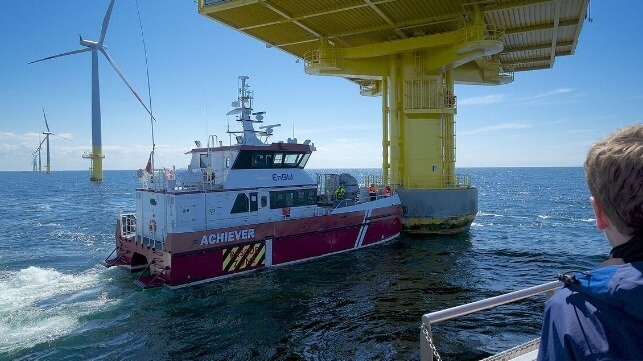Right Whale Speed Limits Could Affect U.S. Wind Farm Costs

The offshore wind industry is concerned about the National Oceanic and Atmospheric Administration's planned vessel speed limit for North Atlantic right whale protection, which would affect budgets for wind farm capex and opex. The industry-standard crew transfer vessel (CTV) is a day-boat, and even at 20 knots it can only go so far out and back in the course of a work day. Running that same boat at 10 knots reduces its reach, and a wind farm that can't be reached with a CTV has to be served with a much larger and more expensive service operations vessel (SOV). This raises the ongoing operating expense - and necessitates the construction of more Jones Act SOV hulls.
The North Atlantic right whale was heavily targeted by whalers in the 19th century, and its population has never fully recovered. Its numbers have been in decline for years and it is now critically endangered. There are about 364 of the whales left, and the survival of the species is now down to the survival of each individual - especially the 88 identified females of breeding age. The two major threats to its survival are lobster/crab pot lines and ship strikes.
NOAA currently has a 10-knot vessel speed limit in effect for larger vessels in two seasonal management areas, one in the northeast and another in the southeast. For vessels under 65 feet - like CTVs - the speed rules do not currently apply. A recent NOAA study found that this could be a problem, because small vessel strikes at high speed can also be lethal.
When they come online and begin operating at scale, CTVs will operate at high speed, and typical examples can make 22-29 knots. The offshore wind industry is concerned that while a 10-knot limit might be good for whales, it will seriously crimp a business model built around 20+ knots.
"That has huge cost implications for the offshore wind industry. One of the first kind of decisions you make with your project when it comes to vessels is if you're going to be CTV based or SOV based, and going 10 knots doubles the amount of time that you're transiting," said Claire Richer, offshore wind director for American Clean Power, in a panel discussion at WorkBoat. "What's killing us the most is that there's no innovative way to go 10 knots."
Richer emphasized that there are other ways to go about the problem, like identifying where the whales are located and slowing down in these areas - not everywhere. "And so we're pushing NOAA to think a little bit more innovatively and push for some of these technological ideas instead of just a blanket 10 knots," she said.
Developer Vineyard Wind is already deploying one part of such a technological solution. It is working with Boston-based Charles River Analytics on computer vision technology to watch out for whales and other contacts at long distances, giving crews early warning. Charles River says that its system can accurately detect whales about 80 percent of the time and ships 90 percent of the time. This will help designated protected species observers (PSOs) to spot marine mammals and take measures to minimize any harm.
Aerial observation could be another piece of the puzzle. Canadian startup Whale Seeker has secured a $500,000 contract from Innovative Solutions Canada to test out its technology to detect marine species and biodiversity. Its AI tool has been trained using multiple data sets to identify marine mammals from aerial photographs. The system uses a “human-in-the-loop” approach, combining the processing power of computer models with the expertise of marine scientists to sort the outline of a whale from a patch of seaweed. Innovations like this could provide the technical basis for careful, automated whale tracking.
